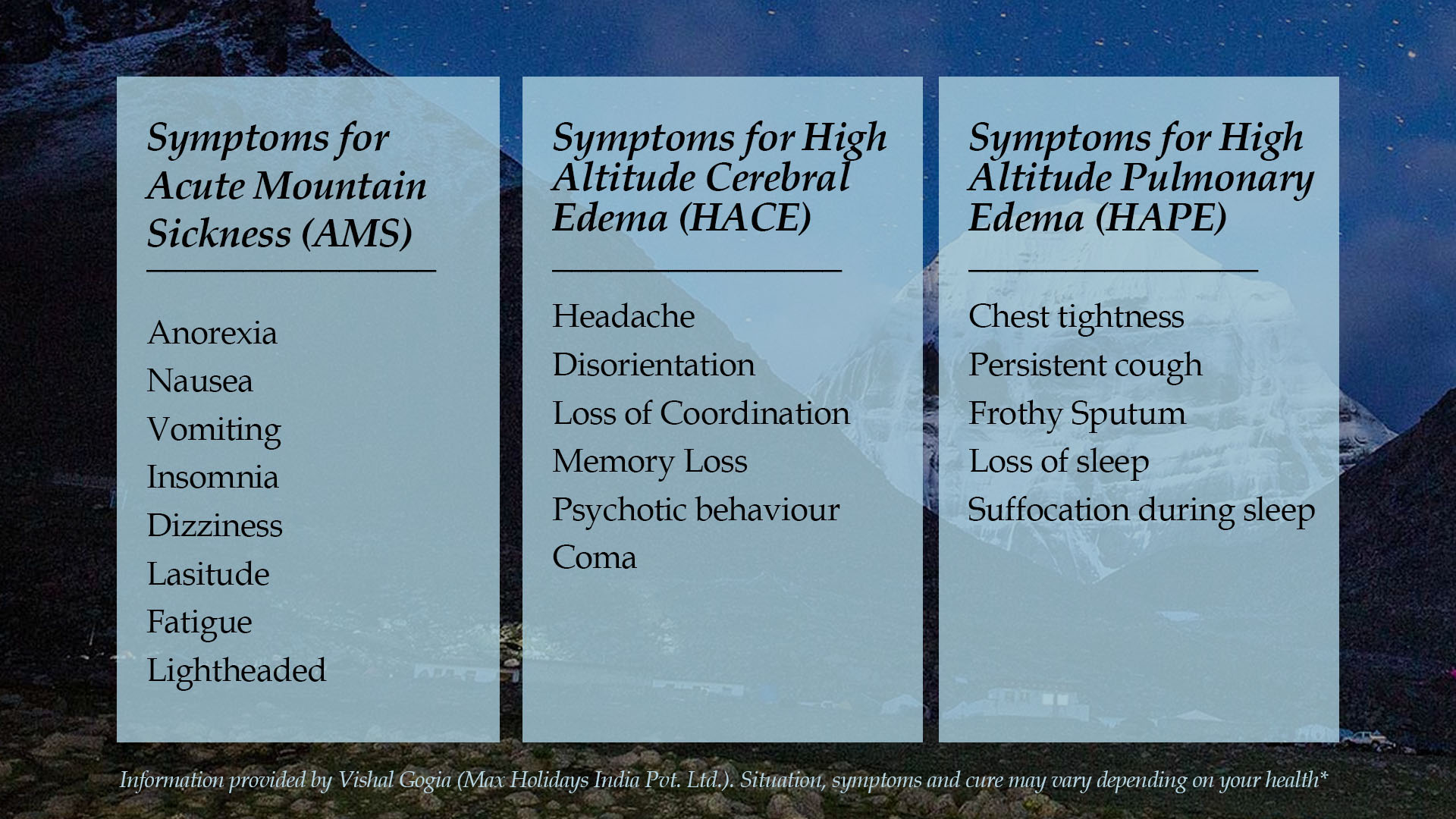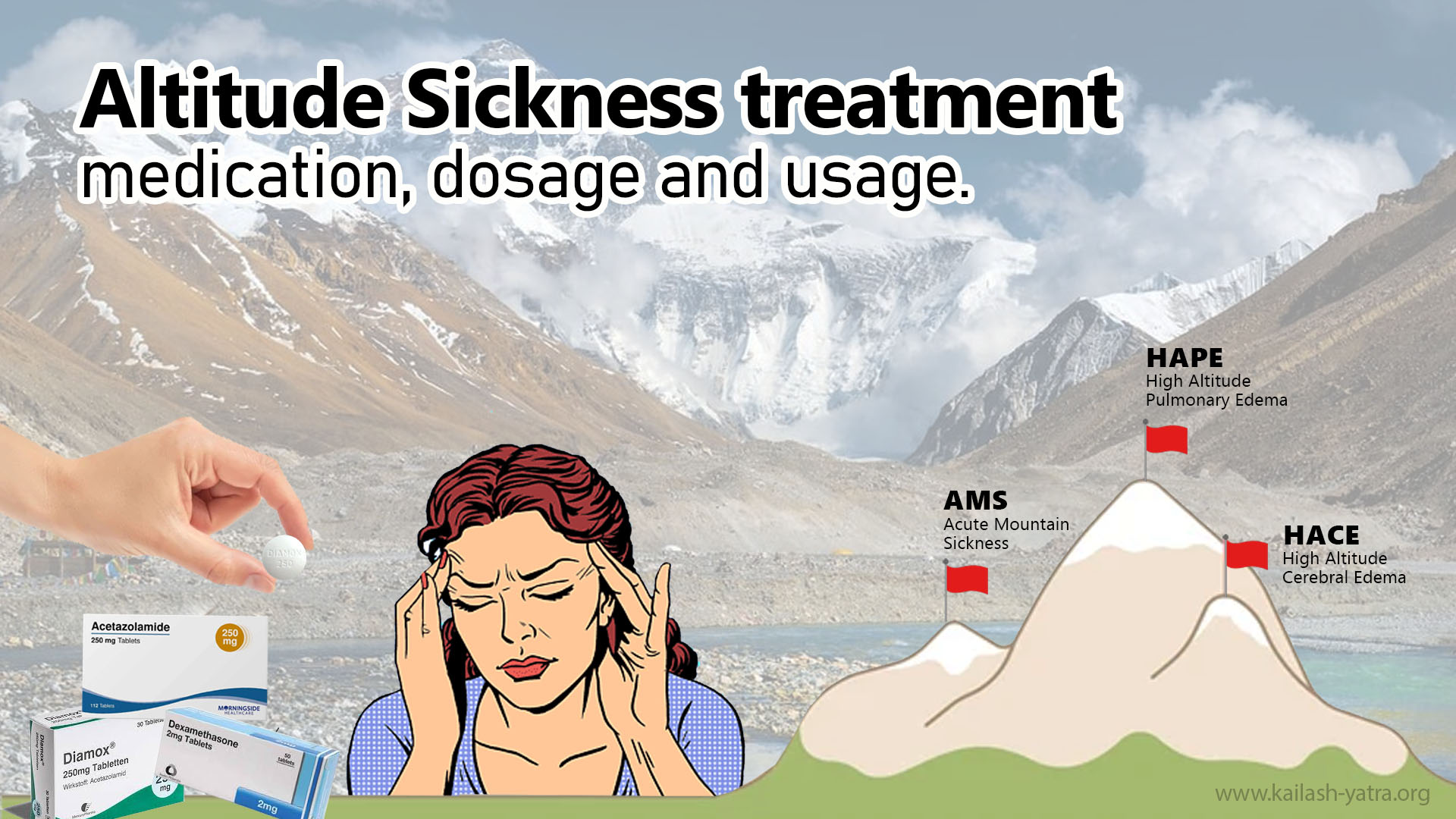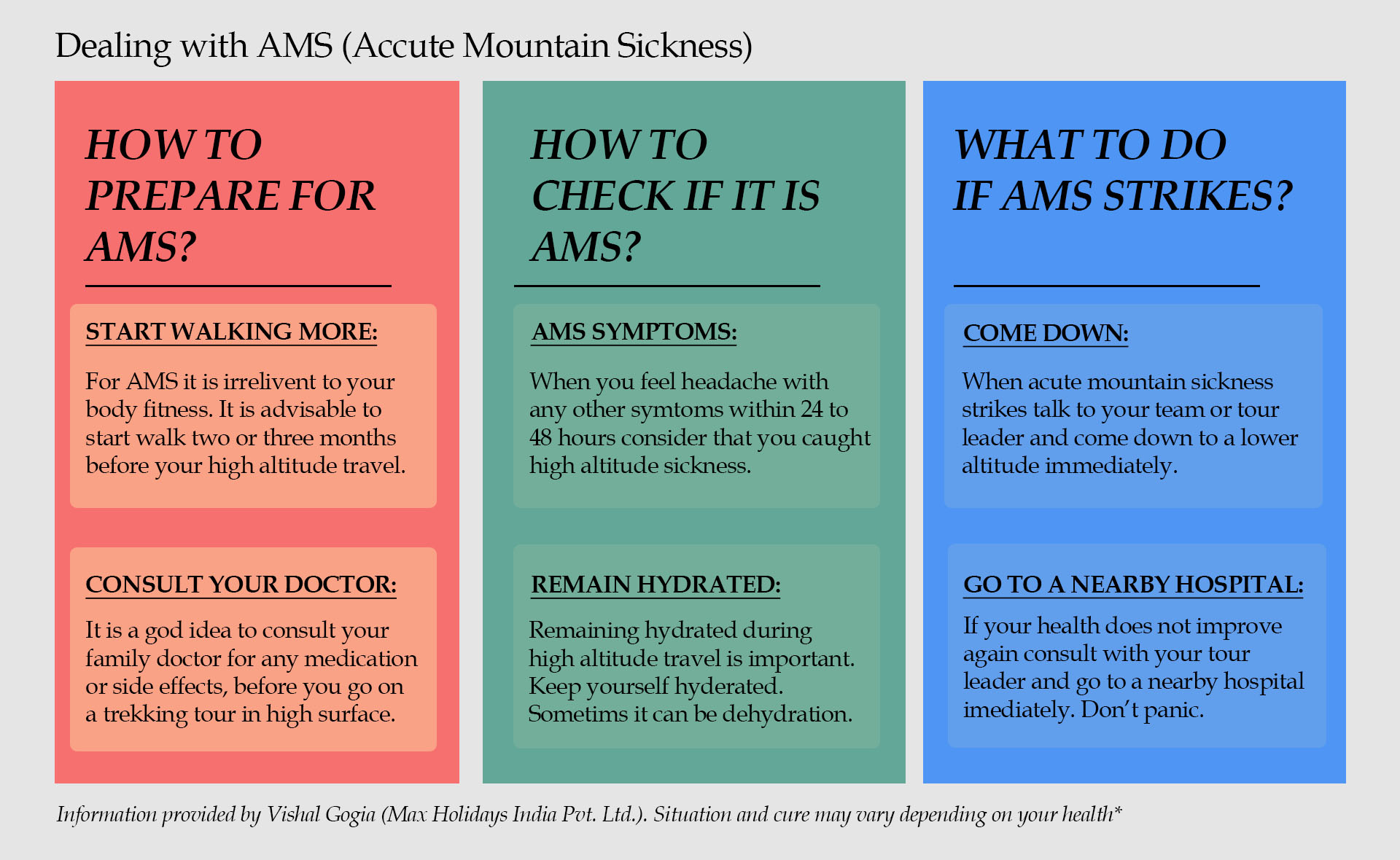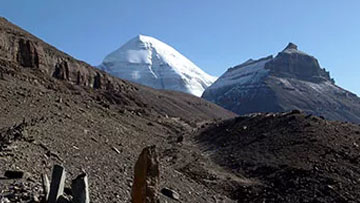
Contributor
Vishal Gogia
August 24, 2024High Altitude Sickness - also referred as 'Altitude Sickness' is a condition that surfaces when you are climbing heights that are above 8,200 feet (2,500 metres). This condition occurs when your body struggles to get enough oxygen, and fails to adapt to its surroundings at that height. This condition leads to a great extent of complications and life threatening situations. Here, we will take you through the varied types of height sickness, the medical conditions that increase risk, its medication, its side-effects as well as the prevention strategies. In this blog I have tried to provide some basic and important infrmation about different stages of high altitude sickness, symptoms of high altitude sickness and different ways for prevention. The main idea behind this page is to provide handful information about high altitude sickness for your Kailash Mansarovar Yatra tour. Read this before your go and do not forget to consult your doctor to give you more advices based on your health condition.
Types of High Altitude Sickness
High Altitude sickness can be categorised into three segments. Each of these has different levels of severity and require different approaches to treat it. Here is all the required information on different high altitude illnesses - causes, medication and treatment.
Acute Mountain Sickness (AMS)
AMS is the most generic condition that can be seen in an individual after 6-24 hours of climbing the height. The condition is similar to that of a hangover. Some of the symptoms of acute mountain sickness are:
- Nausea and headache.
- Dizziness
- Low or no appetite
- Fatigue & Insomnia
- Causes and risk factors
The main driver of AMS is low oxygen levels in the atmosphere at elevated altitudes. Risk variables involve rapid ascent sans sufficient adaptation, vigorous workouts shortly after arrival, and personal sensitivity.
- Medication and Treatment
Individuals suffering from AMS don't need medication. The symptom resolves itself with the passage of time and as the body accommodates to its surroundings. However, if the symptoms worsen, you have to move to a lower altitude. It will be enough to resolve the issue.
High Altitude Cerebral Edema (HACE)
This condition surpasses High Altitude Pulmonary Edema as well and can't be treated promptly - High Altitude Cerebral Edema is the most critical altitude sickness that leads to fluid concentration in the brain, leading it to swelling. It is often fatal and can result in severe brain haemorrhage and even death. It's signs or symptoms are the following:
- Extreme headache and confusion.
- Ataxia
- Hallucinations
- Comatosis.
- Causes and risk factors
The true reason for HACE is unknown, but it is thought to be a spike in cerebral pressure caused by the buildup of fluid. Potential hazards comprise quick ascent, lack of adapting, and previous episodes of alpine illness.
- Medication and Treatment
Individuals suffering from High Altitude Cerebral Edema need to be brought down from the elevation immediately and have to get oxygen supply as soon as possible. Also, they need to be given dexamethasone - it is a corticosteroid - it helps in reducing the brain swelling. Thus, lowering the fatality rate.
High Altitude Pulmonary Edema (HAPE)
HAPE or High Altitude Pulmonary Edema is the severe version of high altitude sickness as it has more complicated conditions. In High Altitude Pulmonary Edema, the lungs accumulate liquid which impair your lungs, disrupting the absorption of oxygen. It's symptoms are as follows:
- Shortness of breath
- Cough or bloody sputum
- Congestion in the chest
- Cyanosis/weakness & fatigue.
- Causes and risk factors
HAPE is a condition that impacts your heart- it is caused when your pulmonary veins get distressed because of the increased pressure. It results in leakages of fluid in the lungs tissue. Risk factors include a history of HAPE, rapid ascent, extreme exertion, and cold exposure. It occurs generally to mountain climbers.
- Medication and Treatment
To treat High Altitude Pulmonary Edema, you have to move to a lower altitude. Combining the administration of oxygen. Also, you need to give medication - dexamethasone - it is a corticosteroid - it helps in reducing the brain swelling.

Condition that increase the risk of HAS (High Altitude Sickness)
There are certain medical conditions that are responsible for increasing the severity of altitude sickness. These conditions aid in worsening the situation and often lead to fatal conditions. So if you are suffering from any of the conditions mentioned below, avoid travelling to high altitude places as it will be life threatening. If you have such a medical issue and want to travel still on this challenging high altitude travel to Kailash Mansarovar, it is stricktly recommended that you consult with a qualified doctor and obtain a medical certificate.
- Asthma and COPD (Chronic Obstructive Pulmonary Disease)
If you have conditions like - asthma or COPD then you are going to have a hard time. These medical conditions worsened the situation because of reduced oxygen level, dry air and cold conditions . These conditions trigger bronchospasms complicating your condition. You should avoid going to high altitude places.
- Cardiovascular disease
Individuals who are suffering from conditions like - hypertension and coronary artery disease then you are at higher risk of having High altitude sickness. With this condition, when you reach a certain elevation, then your heart finds it difficult to pump blood, so avoid going to high altitude places as it will be life threatening for you.
- Anaemia
Anaemia, defined as low haemoglobin levels in the blood, can impair oxygen-carrying ability, making acclimatisation more difficult and raising the risk of altitude sickness. Check your haemoglobin and blood levels before climbing the height.
- Sleep apnea
- Sleep apnea/Insomnia also trigger the condition and complications at the high altitude. High Altitude may disrupt your sleep, leading to poor sleep quality and increased fatigue. This further worsen the altitude sickness condition in individuals.
- Diabetes
Diabetes is also a complicated condition in which you skip climbing to high altitude. Since diabetes impacts your metabolism - it also increases fatigue, weakness and physical stress causing a spike in your blood sugar levels.
Altitude Sickness treatment - medication, dosage and usage.
There is more than one medication that can be administered to individuals suffering from high altitude sickness. These drugs are to be given in different situations, in different amounts and they can't be used in all cases simultaneously.

Acetazolamide (Diamox)
Acetazolamide is the most common medicine that is being prescribed to the individuals suffering from AMS. It also serves as a preventive medicine. It increases the acidity in the blood that stimulates breathing and increases the oxygen delivery in your blood.
Dosage
To prevent the AMS, the climber's are to be given around 125 mg to 250 mg two times a day before the ascending date till two days after you ascended the height. This potentially reduces the risk of AMS. You are suggested to use the medicine until the symptoms subside.
Side effects
Some of the side effects that you may feel are tingling in the fingers and toes as well as increased urination and metallic taste on the tongue.
Dexamethasone
Dexamethasone - a corticosteroid - is used when there are severe cases of AMS, HACE and sometimes HAPE. It's administered to reduce the swelling in the brain and lungs that has accumulated the liquid obstructing Oxygen supply.
Dosage
You need to give 4 mg every 6 hours for HACE. In the severe case of AMS, a similar dose can be administered to the patients. It will reduce the fatality of the condition and reduce risk.
Side effects
Sleeplessness, Hunger, mood swings and increase in blood sugar level are some of the side effects of dexamethasone.
Nifedipine
Nifedipine is a blocker of calcium channels that prevents and treats HAPE. It acts by easing the blood arteries in the lungs, which lowers pressure in the pulmonary arteries and prevents fluid leaks.
Dosage
You need to administer 30 mg every 12 hours to sustain the condition and improve it.
Side effects
The side effects of nifedipine are hot flushing sensation, dizziness as well as low blood pressure.
Aspirin and Ibuprofen
These are the non steroid anti inflammatory medications that help ease the headache that is associated with AMS.
Dosage
Aspirin 325 mg - it is to be given every four to six hours. When it comes to ibuprofen - it is to be given 400 mg every four to six hours.
Side effects
Some of the side effects of aspirin and ibuprofen are gastrointestinal irritation, bleeding, and kidney function impairment.
Oxygen Therapy
This is the most effective therapy for all forms of High altitude sickness. To rapidly increase the oxygen saturation in blood, it is administered using an oxygen mask, which reduces the risk and fatalities associated with HAS.
High altitude sickness - preventive measures and non medical aids
Apart from medicine and medical aids there are certain non medical aids that can help reduce the risk of high altitude sickness. It helps in reducing fatalities and elevates your experience. We have listed them below.
Gradual ascending
Go slow - this is the key to remain fit and fine - yes that's right. You are advised to climb 300 to 500 metres every day and then let your body rest and adapt to the surroundings. In this way you can ascend to the desired height in 3-4 days without encountering significant challenges.
Adaptation
If you take a break and rest at intermediating altitude then it will help your body adjust with the reduced level of oxygen. You may rest a few days at the base camp before you climb any further. It will help your body to adjust according to the surrounding conditions.
Stay Hydrated
Drink around 3-4 litres of water when you are on your way to the paramount. It will help your body keep energised. However, you are advised not to drink too much water as it might cause hyponatremia (low sodium levels).
Don't smoke and drink
Alcohol and smoke significantly reduce the capacity of oxygen carriers in your blood. Alcohol and smoking can exacerbate the symptoms of altitude sickness. Alcohol depresses respiration, while smoking reduces the oxygen-carrying capacity of the bloodstream.
Health condition
A good physique always aids you in challenging scenarios. If you have a good build then your organs might not struggle to absorb and carry oxygen all across your body. However, you must avoid excessive exercising upon reaching a higher altitude.
Food and Nutrition
Carbs are essential - it is more appropriate than fat or protein. You are also suggested to take small meals throughout the day to keep you energised and maintain the energy. Also it requires less oxygen to metabolise, hence is an ideal food choice for high altitudes.
Use of Portable Hyperbaric Chambers
Portable hypoxia tanks can be employed in distant regions to replicate descent by raising the pressure surrounding the body, resulting in more oxygen accessible. It can be a crucial strategy for people suffering from acute altitude sickness when rapid lowering cannot be an option.
Have proper gear
Low temperatures at high elevations raise the risk of HAPE and frostbite. Having layers of thermal apparel and shielding the exposed skin can help sustain the internal temperature and relieve strain on both the cardiovascular and respiratory systems.

Conclusion
High Altitude Sickness is a life threatening situation that often happens because of lower oxygen level in blood, fluid accumulation in lungs and brain and other medical conditions. However if you know the right preventive measures as well as medication then you will have no difficulty whatsoever. So before travelling to high altitude places make sure you are well aware about all the medication as well as preventive measures that you should take to avoid any life threatening situation.
Travelling to Mt. Kailash? Click here to check some important stats about challenges faced by our past travelers and their success rate on this trip.
Kailash Mansarovar Yatra Blog

The Four Faces of Holy Mount Kailash
Soaring up to a massive height of 22,000 feet is Mount Kailash that is prayed by majority of the religions all across the globe. This holy place has always maintained a special place in the hearts of its visitors since it is known as the abode of Lord Shiva.

An Ultimate Guide to Mount Kailash Inner Kora and Outer Kora
The unbelievable and the ultimate journey to the ‘Centre of Universe’ i.e. Mount Kailash has always been counted amongst the most passionately followed divine walks. No pilgrim goes back empty handed on concluding the trek to Mount Kailash- such is the miraculous aura of Kailash Parvat....

Kailash Manasarovar Yatra - Beginning Of A New Life
The Kailash Manasarovar Yatra is known as one of the toughest treks experienced by the pilgrims but its results are concluded as highly fruitful. The Mount Kailash i.e. the heavenly abode to Lord Shiva lies at an elevation of 21,788 ft. above sea level and its journey is thus considered to be the pinnacle of all destinations.

